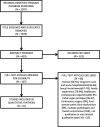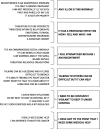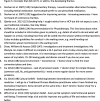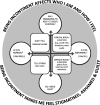A meta-ethnography to understand the experience of living with urinary incontinence: 'is it just part and parcel of life?'
- PMID: 31941470
- PMCID: PMC6964106
- DOI: 10.1186/s12894-019-0555-4
A meta-ethnography to understand the experience of living with urinary incontinence: 'is it just part and parcel of life?'
Abstract
Background: Urinary incontinence (UI) is highly prevalent and affects the lives of many men and women. We aimed to conduct a qualitative evidence synthesis (QES) to explore the experience of living with UI and to develop a conceptual model that can help us to understand this experience, and the potential barriers to appropriate healthcare.
Methods: We used the methods of meta-ethnography developed by Noblit and Hare and recently refined for larger studies. Meta-ethnography involves identifying concepts from the studies and abstracting these concepts into a line of argument. We searched for studies that explored the experience of adults with UI. We used the GRADE-CERQual framework to assess confidence in review findings.
Results: We screened 2307 titles, 429 abstracts, 107 full texts and included 41 studies (36 unique samples) in the synthesis. We organised the concepts into 26 conceptual categories, which we further abstracted into 6 themes: (1) Am I ill or is this normal? (2) It effects who I am and how I feel; (3) I feel stigmatised, ashamed and guilty; (4) talking can be difficult but it can help; (5) keeping incontinence under control; (6) have I got to the point that I need help? Our model conceptualises living with UI as navigating antagonists: Is UI normal or am I ill? Do I need help or am I managing? Do I keep UI to myself (and manage alone) or do I tell other people (and get the support that I need)? Do I use control strategies that focus on concealing (avoid risky situations, wear pads) versus, I use strategies that focus on improving the bodily function to improve continence. Our model highlights the experience of stigma, shame and guilt which exert a pull towards concealment.
Conclusions: The culture of secrecy and profound sense of shame is barrier to seeking help. An environment which reduces the shame and stigma of UI may help people to switch the focus to strategies that will improve continence, rather than conceal incontinence.
Keywords: Incontinence; Meta-ethnography; Qualitative evidence synthesis; Qualitative research.
Conflict of interest statement
The authors declare that they have no competing interests.
Figures




Comment in
-
Geriatrics.J Urol. 2021 Aug;206(2):451-454. doi: 10.1097/JU.0000000000001853. Epub 2021 May 12. J Urol. 2021. PMID: 33975453 No abstract available.
Similar articles
-
Depressing time: Waiting, melancholia, and the psychoanalytic practice of care.In: Kirtsoglou E, Simpson B, editors. The Time of Anthropology: Studies of Contemporary Chronopolitics. Abingdon: Routledge; 2020. Chapter 5. In: Kirtsoglou E, Simpson B, editors. The Time of Anthropology: Studies of Contemporary Chronopolitics. Abingdon: Routledge; 2020. Chapter 5. PMID: 36137063 Free Books & Documents. Review.
-
"It Is a Big Spider Web of Things": Sensory Experiences of Autistic Adults in Public Spaces.Autism Adulthood. 2023 Dec 1;5(4):411-422. doi: 10.1089/aut.2022.0024. Epub 2023 Dec 12. Autism Adulthood. 2023. PMID: 38116051 Free PMC article.
-
Using Experience Sampling Methodology to Capture Disclosure Opportunities for Autistic Adults.Autism Adulthood. 2023 Dec 1;5(4):389-400. doi: 10.1089/aut.2022.0090. Epub 2023 Dec 12. Autism Adulthood. 2023. PMID: 38116059 Free PMC article.
-
"I've Spent My Whole Life Striving to Be Normal": Internalized Stigma and Perceived Impact of Diagnosis in Autistic Adults.Autism Adulthood. 2023 Dec 1;5(4):423-436. doi: 10.1089/aut.2022.0066. Epub 2023 Dec 12. Autism Adulthood. 2023. PMID: 38116050 Free PMC article.
-
Impact of residual disease as a prognostic factor for survival in women with advanced epithelial ovarian cancer after primary surgery.Cochrane Database Syst Rev. 2022 Sep 26;9(9):CD015048. doi: 10.1002/14651858.CD015048.pub2. Cochrane Database Syst Rev. 2022. PMID: 36161421 Free PMC article. Review.
Cited by
-
Comparative Assessment of Female Sexual Function Following Transobturator Midurethral Sling for Stress Urinary Incontinence.Int J Environ Res Public Health. 2021 Feb 25;18(5):2286. doi: 10.3390/ijerph18052286. Int J Environ Res Public Health. 2021. PMID: 33669050 Free PMC article.
-
Pelvic floor muscle training for female urinary incontinence: development of a programme theory from a longitudinal qualitative case study.BMC Womens Health. 2024 Aug 31;24(1):478. doi: 10.1186/s12905-024-03308-4. BMC Womens Health. 2024. PMID: 39217312 Free PMC article. Clinical Trial.
-
The experience of women reporting damage from vaginal mesh: a reflexive thematic analysis.EClinicalMedicine. 2023 Mar 23;58:101918. doi: 10.1016/j.eclinm.2023.101918. eCollection 2023 Apr. EClinicalMedicine. 2023. PMID: 37007734 Free PMC article.
-
Beliefs and strategies about urinary incontinence: a possible moderation role between symptoms and sexual function, and quality of life.Front Psychol. 2023 Nov 30;14:1252471. doi: 10.3389/fpsyg.2023.1252471. eCollection 2023. Front Psychol. 2023. PMID: 38098533 Free PMC article.
-
Experience of Playing Sport or Exercising for Women with Pelvic Floor Symptoms: A Qualitative Study.Sports Med Open. 2023 Apr 25;9(1):25. doi: 10.1186/s40798-023-00565-9. Sports Med Open. 2023. PMID: 37097457 Free PMC article.
References
-
- Hay-Smith E, Herderschee R, Dumoulin C, Herbison G. Comparisons of approaches to pelvic floor muscle training for urinary incontinence in women (Review) Cochrane Database Syst Rev. 2011;12(CD009508):1–110. - PubMed
-
- Noyes J, Popay J, Pearson A, Hannes K, Booth A. Qualitative research and cochrane reviews. In: Higgins J, Green S, editors. Cochrane Handbook for Systematic Reviews. Chichester: Wiley; 2008.
MeSH terms
LinkOut - more resources
Full Text Sources
Medical
Miscellaneous

